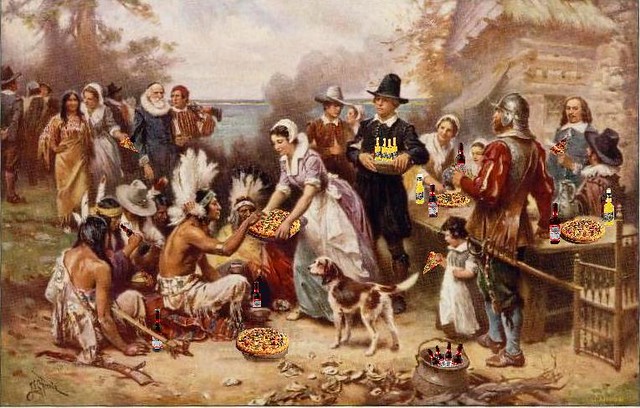Be cognizant of the bleak history of the holiday

The warm images of Thanksgiving do not tell the full truth.
Thanksgiving is a holiday filled with gratitude, family and feasts. People of different relations come together to celebrate and the atmosphere is usually wholesome and celebratory.
This feeling is unsurprising considering how children are introduced to the history of the holiday. Most college students are familiar with the story about the traditions of Thanksgiving leading back to the pilgrims.
As we were told, English pilgrims who were working to establish the Plymouth Colony in 1620 were struggling to survive. In this tale, the Native Americans came to their aid and they shared a large feast in what became known later as Thanksgiving.
According to TIME magazine, the feast included 90 men from the Wampanoag tribe and around 50 Mayflower passengers.
The reality of the holiday’s history is far more muddied and certainly much darker than the history we teach school children today.
There are several claims existing as to when and where the first Thanksgiving took place. It may have been in 1620 in current-day Massachusetts as we were told, but, as can be found on the History of Massachusetts page, it is more likely that the first ‘true’ Thanksgiving didn’t take place until 1623 during a much more religion-focused feast.
Thanksgiving had far less to do with coming together with neighbors and family and far more to do with religious observation. 1623 marked the first meal that required such religious practices for all attendees.
However, far more disturbing than the stories of the feast first taking place at the welcoming 1620 feast or the Christian focused 1623 feast, but, as HuffPost reported, it likely took place in 1673 to celebrate the return of colonial soldiers who had murdered 700 Pequot men, women and children.
Governor John Winthrop declared their return as a day of Thanksgiving, leading to the household name we celebrate today. Far from the idyllic picture of individuals of different backgrounds coming together, the reality of Thanksgiving is laced in a history of genocide and violence.
Even the Wampanoag tribe which attended the feasts in the early 1620s were eventually wiped out by British settlers as tensions rose, people were driven from their lands and their chief, Metacomet, was slaughtered.
According to the novel, “It Happened in Rhode Island,” Metacomet was dismembered and his head was placed on a pike that remained on display in Plymouth for 25 years. Metacomet’s remaining tribe members and allies were then sold into slavery in the West Indies.
Our current understanding of Thanksgiving is a false tale that has only been around for the last 120 years, and as a result of textbooks, is largely believed by the general populace.
Surely, the story most of us know if a wholesome and good one: a story of friendship and understanding of different people. However, it is irresponsible to ignore the harm that came to Native populations as a result of relations with groups such as the Plymouth pilgrims.
Instead of neglecting to recognize the holiday, we should recognize it as a warning. A lack of empathy and an overabundance of greed are what led to the atrocities of the past. So on this day of thanks, be thankful that you are privileged enough to be with those you love and care about and be understanding of those who do not wish to celebrate the holiday.
